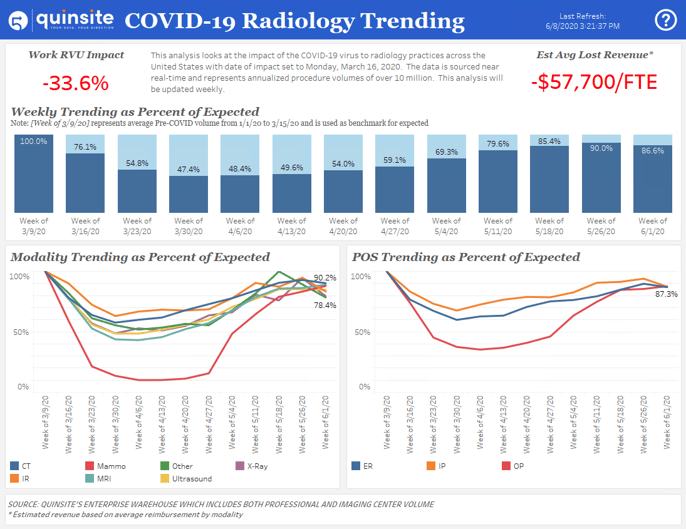Quinsite Signs Partnership with LucidHealth
Driving Positive Outcomes for Patients and Imaging Services Partners with Integrated Insights

The COVID Impact
We can all agree that COVID profoundly affected every aspect of our lives. It created significant strain on our healthcare system, challenging organizations big and small to quickly navigate uncharted territory.
Health systems and private practices nationwide were desperate for reliable insights into disease statistics and patient volume trends to help forecast the future and guide critical decisions around facilities and staffing. While patient safety and quality of care remained the priority, most organizations battled uncertainty around sustaining operations in the face of dramatically reduced revenue. Quality data analytics rapidly elevated from being a luxury to becoming an essential tool for successful healthcare administration.
In 2020, during the height of the pandemic, Quinsite produced weekly radiology volume updates to help practice leaders keep an eye on the nationwide impact to imaging trends. “Quinsite provided us with valuable information for decision making during Covid,” said Becky Thompson, CFO/COO at American Medical Imaging Consultants in Colorado, “without this solution I can’t imagine how we would have gotten all the data we needed during that time.”

A Harvey L. Neiman Health Policy Institute retrospective study of outpatient imaging volumes between January 2019 and August 2020 highlights that radiology volumes dropped 57% (90% for mammography specifically) at the height of COVID from the same period the previous year1. This evidence supports the above near real-time trends generated by Quinsite.
That same study shows that while volumes recovered quickly, revenue for many independent radiology practices continued to lag due to a decrease in more complex higher-reimbursement imaging services paired with an increase in lower-reimbursement services. These lower-reimbursement services may have minimized the risk of virus transmission to the technical staff and patient population, but they increased the time and resources required to perform them.
With no real end to COVID in sight, many practices are still struggling to get back to pre-pandemic revenue levels, putting some at greater risk for consolidation. As a result, they are being prompted to invest in new technologies and processes to improve existing revenue as well as generate new revenue, as part of a successful healthcare revenue cycle management strategy.
How do advanced analytics help?
Timely, reliable, actionable insights should offer visibility into fine details as well as a comprehensive overview of each business process, function, location, and service line. Arming leadership with easy access to high-quality analytics allows them to better understand trends, identify problems, guide appropriate tactics, and measure effectiveness.
Quinsite’s Comprehensive Healthcare Analytics Platform™ allows practice leaders to monitor revenue trends in real-time, audit billing and payments, track budgets, and more. Examples of reports available through the platform include:
Reconciling Data, Capturing Revenue
As the U.S. healthcare system grows, medical billing has become frustratingly more nuanced and complex. Quinsite CEO, Jeff Maze, explains how auditing the entire billing process (i.e. tracking every exam from patient to payment) is more important than ever before and creates potential for significant financial gains. A consistent, robust audit process can help practices quickly identify billing discrepancies that often result from disparate billing systems or data sources and support a successful healthcare revenue cycle management strategy.
South Hub Radiology in Chicago was able to identify more than $200,000 in uncaptured charges utilizing Quinsite’s Charge Capture Audit tool. Line-item detail helped leadership discover and correct the source of the issue, which allowed them to collect missed revenue as well as improve timeliness of payments going forward to stabilize cash flow. To learn more, read the full case study HERE
Similarly, ARA Health Specialists in North Carolina realized more than $200,000 in revenue leveraging Quinsite’s Charge Capture Audit tool which helped combine their hospital, vendor, and physician dictation data feeds for a continuous comparison of charges created to charges actually billed. Several coding discrepancies were discovered, prompting their team to review services and update their exam code dictionary to ensure accurate reimbursement going forward. To learn more, read the full case study HERE
A number of practices are also using Quinsite’s platform to track referral sources – monitoring increases, decreases, and other referral trends to identify new revenue opportunities, address potential competitive threats, revisit existing provider relationships and/or build new ones. Many groups leverage reports to forecast financial growth and evaluate opportunities for new facilities and specialized services.
These are just a few examples of how high-quality analytics can help practices increase revenue, identify growth opportunities, and strategically maintain independence and long-term organizational sustainability in the presence of COVID and other unknowns.
Discover how to unleash the power of your data.

Driving Positive Outcomes for Patients and Imaging Services Partners with Integrated Insights
.png?width=352&name=Blog%20Images%20-HW%20(2).png)
Chapel Hill, NC, October 31, 2024 – Quinsite, a healthcare analytics software company, announced...

In today’s rapidly evolving healthcare landscape, achieving strong financial returns requires more...